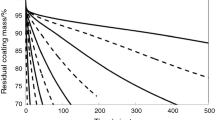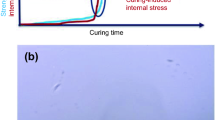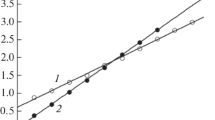Abstract
Results from a polyester-urethane (PU) coating system under accelerated weathering showed that crosslink density, obtained from high-temperature modulus data, diminished due to chain scission. However, T g and room-temperature tensile modulus both increased with weathering. Molecular relaxation phenomena in polymers have long been investigated to explore changes occurring in a polymer at temperatures below its glass transition and were explored for an explanation to supplement chemical degradation for these observations. Relaxation was quantified using “enthalpy recovery” which first increased with exposure, then diminished. The concurrent physical and chemical aging effects were characterized by tracking nonexponentiality in the spectrum of relaxation times, and the size of “co-operatively relaxing regions” deduced from relaxation around the glass transition. Mechanical relaxation in this coating extended longer than cycle periods typical of accelerated weathering, suggesting that frequency effects might be important when comparing accelerated to natural weathering.











Similar content being viewed by others

References
H Ochs, J Vogelsang, G Meyer Enhanced Surface Roughness of Organic Coatings due to UV-Degradation: An Unknown Source of EIS-Artifacts. Prog. Org. Coat., 46(3), 182–190 (2003)
Hinderliter, B, Croll, S, Allahar, K, Stafford, O, Bierwagen, G, Tallman, D, “Using Ionic Liquids to Measure Coating Properties Via Electrochemical Impedance Spectroscopy (EIS).” J. Coat. Technol. Res., Accepted for publication
AD Skaja, BMD Fernando, SG Croll Mechanical Property Changes and Degradation During Accelerated Weathering of Polyester-Urethane Coatings. J. Coat. Technol. Res., 3(1), 41–51 (2006)
G Wypch, Handbook of Material Weathering, 2nd ed. ChemTech Publishing, Toronto, Canada, p. 252 (1995)
(a) Struik, LCE, Physical Aging in Amorphous Polymers and Other Materials. Elsevier Scientific Publications Co., Amsterdam (1978); (b) Angell, CA, Ngai, KL, McKenna, GB, McMillan, PF, Martin, SW, “Relaxation in Glassforming Amorphous Solids,” J. Appl. Phys., 88 (6) 3113–3157 (2000)
JM Hutchinson Physical Aging of Polymers. Prog. Polym. Sci., 20(4), 703–760 (1995)
SL Simon, JW Sobieski, DJ Plazek Volume and Enthalpy Recovery of Polystyrene. Polymer, 42(6), 2555–2567 (2001)
AY Belov, HU Jäger Relaxation Kinetics in Amorphous Carbon Films: An Insight From Atomic Scale Simulation. Thin Solid Films, 482(1–2), 74–78 (2005)
DY Perera Physical Ageing of Organic Coatings. Prog. Org. Coat., 47, 61–76 (2003)
S Montserrat, Y Calventus, JM Hutchinson Physical Aging of Thermosetting Powder Coatings. Prog. Org. Coat., 55(1), 35–42 (2006)
MD Ediger, JL Skinner Single Molecules Rock and Roll Near the Glass Transition. Science, 292, 233–234 (2001)
C Donati, SC Glotzer, PH Poole, W Kob, SJ Plimpton Spatial Correlations of Mobility and Immobility in a Glass-Forming Lennard-Jones Liquid. Phys. Rev. E., 60(3), 3107–3119 (1999)
Moynihan, CT, “Phenomenology of the Structural Relaxation Process and the Glass Transition.” In: Seyler, RJ (ed.) Assignment of the Glass Transition, ASTM STP 1249, pp. 32–49. ASTM, PA (1994)
TS Ellis, FE Karasz, GJ Ten Brinke The Influence of Thermal Properties on the Glass Transition Temperature in Styrene/Divinylbenzene Network-Diluent Systems. J. Appl. Polym. Sci., 28(1), 23–32 (1983)
R van der Linde, EG Belder, DY Perera Effect of Physical Aging and Thermal Stress on the Behavior of Polyester/TGIC Powder Coating. Prog. Org. Coat., 40(1), 215–224 (2000)
A Lee, GB McKenna Effect of Crosslink Density on Physical Ageing of Epoxy Networks. Polymer, 29(10), 1812–1817 (1988)
IM Hodge Enthalpy Relaxation and Recovery in Amorphous Materials. J. Non-Cryst. Solids, 169(3), 211–266 (1994)
Y Calventus, S Montserrat, JM Hutchinson Enthalpy Relaxation of Non-Stoichiometric Epoxy-Amine Resins. Polymer, 42(16), 7081–7092 (2001)
H Lu, S Nutt Restricted Relaxation in Polymer Nanocomposites Near the Glass Transition. Macromolecules, 36(11), 4010–4016 (2003)
OS Narayanaswamy A Model of Structural Relaxation in Glass. J. Am. Ceram. Soc., 54, 491–498 (1971)
CT Moynihan, AJ Eastel, MA DeBolt, J Tucker Dependence of the Fictive Temperature of Glass on Cooling Rate. J. Am. Ceram. Soc. 59(1), 12–16 (1976)
S Montserrat, JM Hutchinson On the Measurement of the Width of the Distribution of Relaxation Times in Polymer Glasses. Polymer, 43(2), 351–355 (2002)
H Lu, S Nutt Restricted Relaxation in Polymer Nanocomposites Near the Glass Transition. Macromolecules, 36(11), 4010–4016 (2003)
G Adam, JH Gibbs On the Temperature Dependence of Cooperative Relaxation Properties in Glass-Forming Liquids. J. Chem. Phy., 43(1), 139–146 (1965)
E Donth The Size of Cooperatively Rearranging Regions in Polystyrene and Styrene-Dimethylsiloxane Diblock Copolymers at the Glass Transition Temperature. Acta Polym., 35(2), 120–123 (1984)
S Krause, M Iskandar, M Iqbal Properties of Low Molecular Weight Block Copolymers. 1. Differential Scanning Calorimetry of Styrene-Dimethylsiloxane Diblock Copolymers. Macromolecules, 15(1), 105–111 (1982)
AT Metters, CN Bowman, KS Anseth A Statistical Kinetic Model for the Bulk Degradation of PLA-b-PEG-b-PLA Hydrogel Networks. J. Phys. Chem. B, 104(30), 7043–7049 (2000)
Acknowledgment
This work was supported by the Air Force Office of Scientific Research, contract number FA9599-04-1-0368.
Author information
Authors and Affiliations
Corresponding author
Additional information
This paper was awarded Third Place in the John A. Gordon Best Paper competition, presented as part of 2006 FutureCoat! Conference, sponsored by Federation of Societies for Coatings Technology, November 1–3, 2006, in New Orleans, LA.
Rights and permissions
About this article
Cite this article
Fernando, B.M.D., Shi, X. & Croll, S.G. Molecular relaxation phenomena during accelerated weathering of a polyurethane coating. J Coat Technol Res 5, 1–9 (2008). https://doi.org/10.1007/s11998-007-9077-1
Published:
Issue Date:
DOI: https://doi.org/10.1007/s11998-007-9077-1



